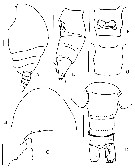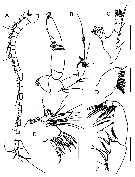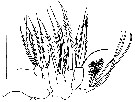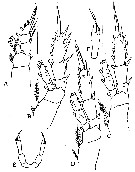|
|
 |
|
Calanoida ( Order ) |
|
|
|
Clausocalanoidea ( Superfamily ) |
|
|
|
Tharybidae ( Family ) |
|
|
|
Tharybis ( Genus ) |
|
|
| |
Tharybis pseudomegalodactyla Ferrari & Markhaseva, 2005 (F,M) | |
| | | | | | | Ref.: | | | Ferrari & Markhaseva, 2005 (p.34, figs.F,M) |  issued from F.D. Ferrari & E.L. Markhaseva in Plankton Biol. Ecol., 2005, 52 (1). [p.35, Fig.1]. Female (13°23'N, 102°27'W): A, habitus (lateral); B, forehead ( dorsal); C, rostrum (left lateral); D, posterior corners of prosome and urosome (dorsal); E, urosome ( left lateral); F, genital complex (ventral); G, idem (dorsal). Scale lines 0.1 mm. Nota: rostrum with 2 thin filaments. Head and Th1 fused, 4th and 5th fused ventrolaterally. Prosome 3.0-3.5 times longer than urosome. Genital complex slightly asymmetrical, in dorsal view small swelling on the left side slightly more pronounced than swelling on righrt. Urosomal somite 2 with posterior epicuticular fringe. Rem: Thoracic somites are Th1-7. Prosome is cephalic somites 1-5 plus thoracic somites 1-6. Urosome is thoracic somite 7 plus all abdominal somites. Caudal rami with 4 large, terminal setae, 1 small mediodorsal seta and 1 small ventral seta
|
 issued from F.D. Ferrari & E.L. Markhaseva in Plankton Biol. Ecol., 2005, 52 (1). [p.36, Fig.2]. Female: A, A1; B, A2; C, Md (mandibular palp); D, Md (mandibular gnathobase); E, Mx1; F, Mxp; Scale lines 0.1 mm. Fig.B: holotype; Figs.A, C-F: paratypes. Nota: A1 24-segmented, reaching the posterior end of 4th thoacic segment. A2: coxa with 1 small seta; basis with 2 setae; endopod 2-segmented ( proximal segment with 2 setae and row of small denticles distally, distal segment with 14 (6 terminal and 8 subterminal setae); exopodite 7-segmented (2nd and 3rd segments from basis incompletely aarticulated) with 0, 0 (+1), 1, 1, 1, 1, 3 setae. Md: coxa with row of stiff denticles originating along medial edge of gnathobase; basis with 3 setae; endopod 2-segmented (proximal with 2 setae and distal with 9 setae); exopod indistinctly segmented apparently with 1, 1, 1, 1, and 2 setae. Mx1: praecoxal endite with 9 terminal, 4 posterior and 1 anterior setae; coxal endite with 3 setae; proximal and distal basal endites with 4 and 3 setae respectively; endopodite with 7 setae (2+2.3); exopodite with 3 setae and exite with 7 setae. mxp: syncoxa with 1 seta on proximal lobe; 2 setae on middle lobe; 3 setae on distal lobe; coxal lobe with 3 setae and distal hairs; all setae sclerotized; basis with row of stiff hairs proximally, 3 setae on unattenuated proximal lobe and 2 setae on distal lobe; endopod 5-segmented with 4, 4, 3, 4 and 4 setae.
|
 issued from F.D. Ferrari & E.L. Markhaseva in Plankton Biol. Ecol., 2005, 52 (1). [p.37, Fig.3]. Female: Mx2 (from holotype). Scale lines 0.1 mm. Nota: Mx2: proximal praecoxal endite with 4 setae, distal with 3 setae; proximal coxal endite with 3 setae, posterior seta poorly-sclerotized, sensory seta without setules; distal coxal endite with 3 setae ( including 1 thick spine-like seta); proximal basal endite with 4 setae, 1 poorly sclerotized sensory seta without setules, and 3 well sclerotized setae with setules; distal basal lobe plus exopod with 8 sensory setae (5 brush-like and 3 worm-like). For the authors, Bradford (1973) was the first to emphasize the kind [worm-like or brush-like] and number of modified setae associated with the ramus of Mx2 in families that are now called 'bradfordian': Diaixidae, Phaennidae, Scolecitrichidae, and Tharybidae [with Parkiidae established later]. The ultrastructure of worm-like and brush-like setae has been elucidated as a chemosensory function to facilitate detritivory (Nishida & Ohtsuka, 1997).
|
 issued from F.D. Ferrari & E.L. Markhaseva in Plankton Biol. Ecol., 2005, 52 (1). [p.37, Fig.4]. Female: A, P1 (anterior); B, P2 (posterior); C, P3 (posterior); D, P4 (posterior); E, P5; F, exopodite 3 of P5. Scale lines 0.1 mm. Figs.A-D: paratypes; E-F, holotype. Nota: P5 3-segmented; coxa and basis unarmed; exopod (distal segment) with 1 articulated medial seta, slightly curved, with setules and 2 spine-like attenuations, terminal with denticles
|
 issued from F.D. Ferrari & E.L. Markhaseva in Plankton Biol. Ecol., 2005, 52 (1). [p.38, Fig.5]. Male: A, habitus (dorsal); B, idem (right lateral); C, right A1 (segments 1-11); D, right A1 (segments 12-19); E, right A1 (segments 20-22). Scale lines 0.1 mm. From paratype. Nota: Prosome 2.2-2.7 times longer than urosome. Cephalon and Th1 fused; Th1-Th2 separate dorsally; Th5-Th6 fused (see metamery in female). Posterior corners of prosome rounded laterally and dorsally. Genital opening on left. Rostrum with 2 small filaments. Right A1 22-segmented; left 23-segmented (segment apparently homologous to the 18th of the right A1 appears divided into 2 segments in left A1 with the proximal segment lacking seta). A2 as for female (except for basis with 1 seta). Md as for female (except for exopodite 2 with 8 setae. Mx1 as for female (except for praecoxa lacking anterior seta and exite with 8 setae. Mx2, Mxp, P1-P2 as for female. P3-P4 as for female (except surface denticulation less dense). right P5 uniramal 4-segmented, exopod 2-segmented (1st segment with several knob-like attenuations along middle segment; left leg biramal, endopd 1-segmented falciform, thin, narrowing distally; exopod 3-segmented, middle segment with distal flange around proximal part of distal segment, distal segment with flange around 2 terminal attenuations.
|
 issued from F.D. Ferrari & E.L. Markhaseva in Plankton Biol. Ecol., 2005, 52 (1). [p.38, Fig.6]. Male: A-B, P5 (in different views); C-E, exopodite 3 of left P5 (in different views. ReM is middle segment of exopod; ReD is distal segment of exopod; Ri is endopod. Scale lines 0.1 mm. From paratype.
|
 issued from F.D. Ferrari & E.L. Markhaseva in Plankton Biol. Ecol., 2005, 52 (1). [p.45, Fig.15A]. Female: A, organ of Von Vaupel Klein on endopod of P1. Nota: Distal edge of knob smooth with 4-6 denticles on anterior face.
| | | | | NZ: | 1 | | |
|
Distribution map of Tharybis pseudomegalodactyla by geographical zones
|
| | | | Loc: | | | E Pacif. (Volcano 7: 13°23 N; 102°27 W) | | | | N: | 1 | | | | Lg.: | | | (932) F: 1,24-1,44; M: 1,12-1,22; {F: 1,24-1,44; M: 1,12-1,22} | | | | Rem.: | bathypelagic: hyperbenthic. | | | Last update : 01/02/2015 | |
|
|
 Any use of this site for a publication will be mentioned with the following reference : Any use of this site for a publication will be mentioned with the following reference :
Razouls C., Desreumaux N., Kouwenberg J. and de Bovée F., 2005-2025. - Biodiversity of Marine Planktonic Copepods (morphology, geographical distribution and biological data). Sorbonne University, CNRS. Available at http://copepodes.obs-banyuls.fr/en [Accessed December 26, 2025] © copyright 2005-2025 Sorbonne University, CNRS
|
|
 |
 |










